Microcontroller Programming - PDF
VerifiedAdded on 2021/06/18
|9
|2073
|21
AI Summary
Contribute Materials
Your contribution can guide someone’s learning journey. Share your
documents today.
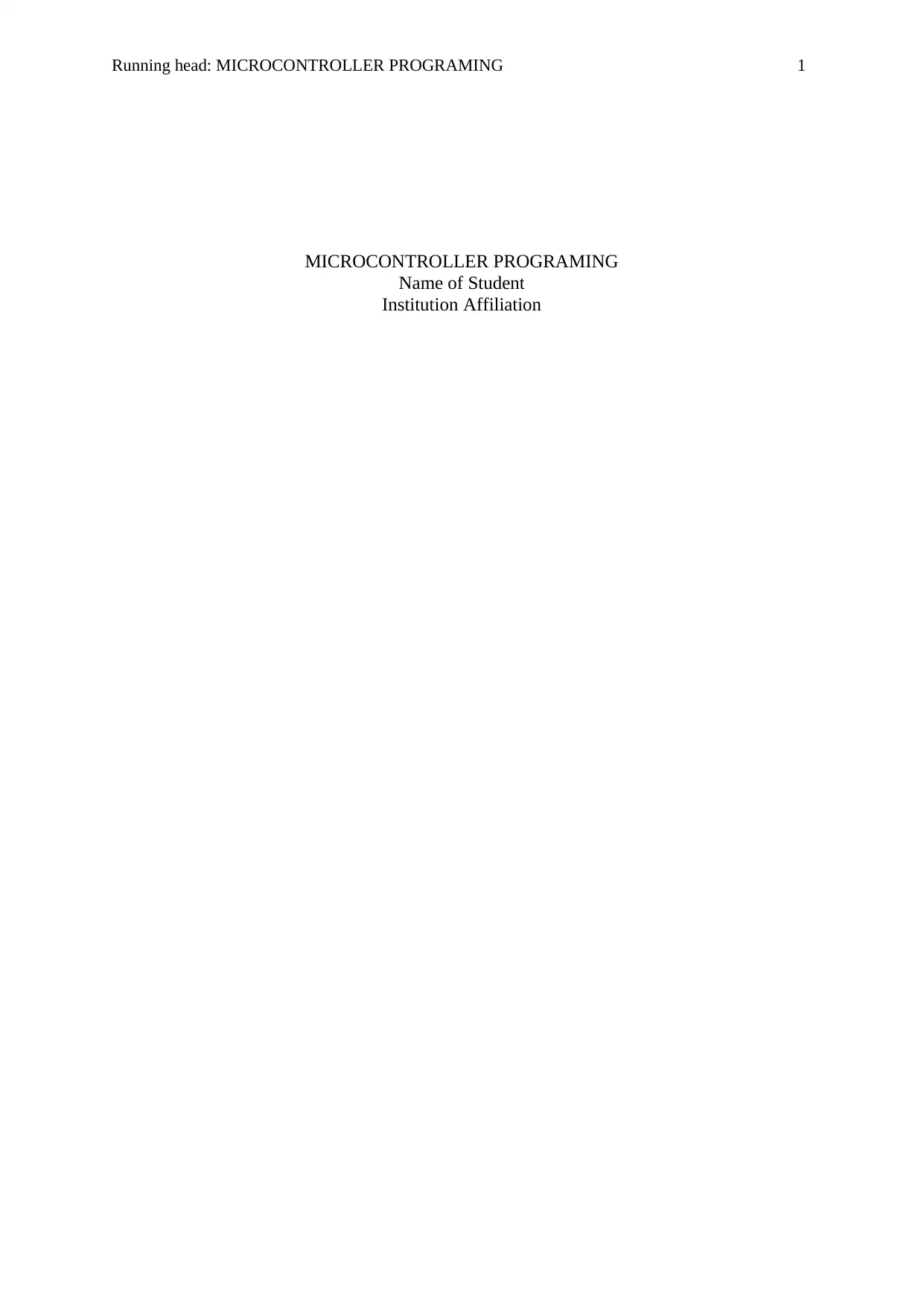
Running head: MICROCONTROLLER PROGRAMING 1
MICROCONTROLLER PROGRAMING
Name of Student
Institution Affiliation
MICROCONTROLLER PROGRAMING
Name of Student
Institution Affiliation
Secure Best Marks with AI Grader
Need help grading? Try our AI Grader for instant feedback on your assignments.
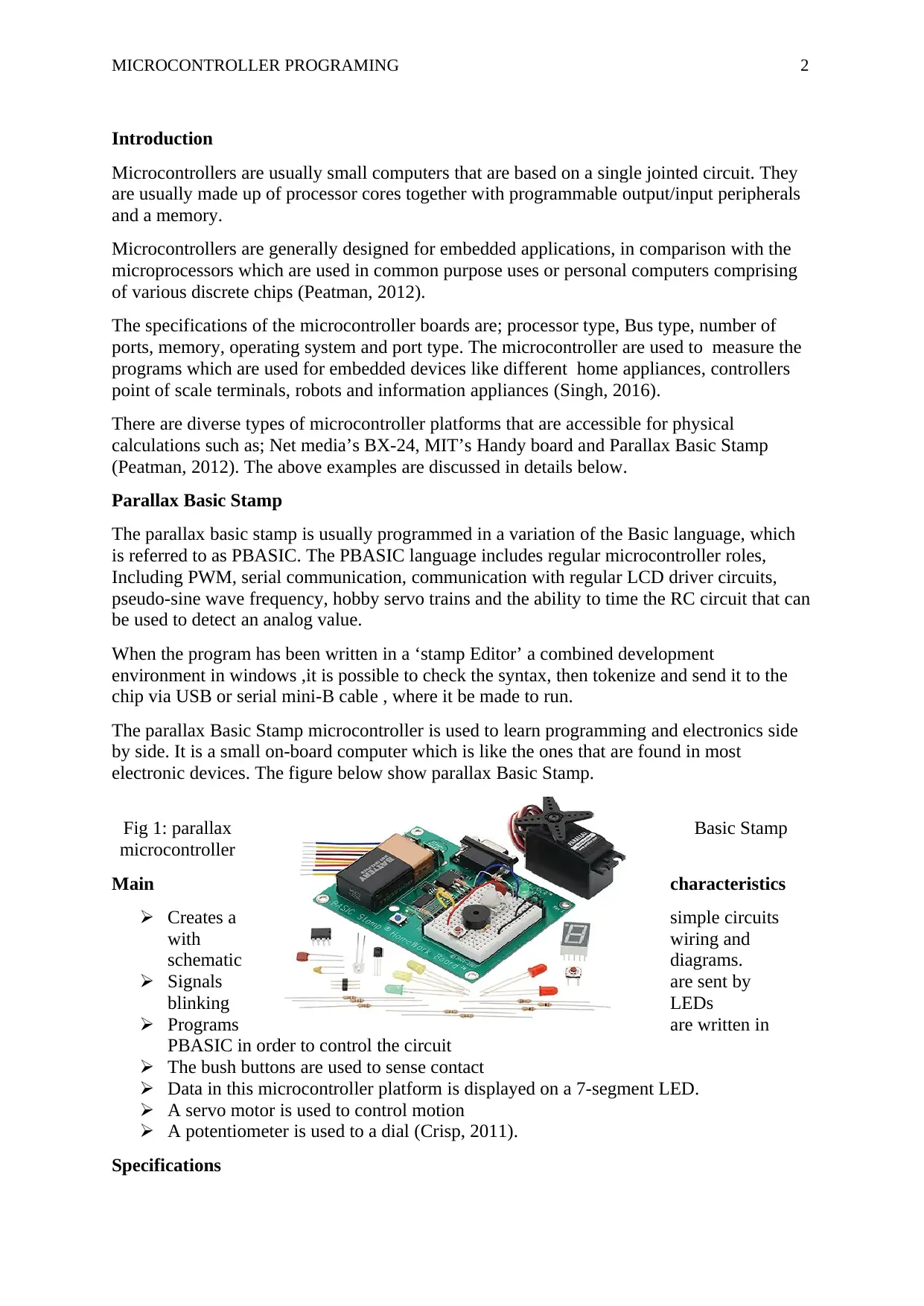
MICROCONTROLLER PROGRAMING 2
Introduction
Microcontrollers are usually small computers that are based on a single jointed circuit. They
are usually made up of processor cores together with programmable output/input peripherals
and a memory.
Microcontrollers are generally designed for embedded applications, in comparison with the
microprocessors which are used in common purpose uses or personal computers comprising
of various discrete chips (Peatman, 2012).
The specifications of the microcontroller boards are; processor type, Bus type, number of
ports, memory, operating system and port type. The microcontroller are used to measure the
programs which are used for embedded devices like different home appliances, controllers
point of scale terminals, robots and information appliances (Singh, 2016).
There are diverse types of microcontroller platforms that are accessible for physical
calculations such as; Net media’s BX-24, MIT’s Handy board and Parallax Basic Stamp
(Peatman, 2012). The above examples are discussed in details below.
Parallax Basic Stamp
The parallax basic stamp is usually programmed in a variation of the Basic language, which
is referred to as PBASIC. The PBASIC language includes regular microcontroller roles,
Including PWM, serial communication, communication with regular LCD driver circuits,
pseudo-sine wave frequency, hobby servo trains and the ability to time the RC circuit that can
be used to detect an analog value.
When the program has been written in a ‘stamp Editor’ a combined development
environment in windows ,it is possible to check the syntax, then tokenize and send it to the
chip via USB or serial mini-B cable , where it be made to run.
The parallax Basic Stamp microcontroller is used to learn programming and electronics side
by side. It is a small on-board computer which is like the ones that are found in most
electronic devices. The figure below show parallax Basic Stamp.
Fig 1: parallax Basic Stamp
microcontroller
Main characteristics
Creates a simple circuits
with wiring and
schematic diagrams.
Signals are sent by
blinking LEDs
Programs are written in
PBASIC in order to control the circuit
The bush buttons are used to sense contact
Data in this microcontroller platform is displayed on a 7-segment LED.
A servo motor is used to control motion
A potentiometer is used to a dial (Crisp, 2011).
Specifications
Introduction
Microcontrollers are usually small computers that are based on a single jointed circuit. They
are usually made up of processor cores together with programmable output/input peripherals
and a memory.
Microcontrollers are generally designed for embedded applications, in comparison with the
microprocessors which are used in common purpose uses or personal computers comprising
of various discrete chips (Peatman, 2012).
The specifications of the microcontroller boards are; processor type, Bus type, number of
ports, memory, operating system and port type. The microcontroller are used to measure the
programs which are used for embedded devices like different home appliances, controllers
point of scale terminals, robots and information appliances (Singh, 2016).
There are diverse types of microcontroller platforms that are accessible for physical
calculations such as; Net media’s BX-24, MIT’s Handy board and Parallax Basic Stamp
(Peatman, 2012). The above examples are discussed in details below.
Parallax Basic Stamp
The parallax basic stamp is usually programmed in a variation of the Basic language, which
is referred to as PBASIC. The PBASIC language includes regular microcontroller roles,
Including PWM, serial communication, communication with regular LCD driver circuits,
pseudo-sine wave frequency, hobby servo trains and the ability to time the RC circuit that can
be used to detect an analog value.
When the program has been written in a ‘stamp Editor’ a combined development
environment in windows ,it is possible to check the syntax, then tokenize and send it to the
chip via USB or serial mini-B cable , where it be made to run.
The parallax Basic Stamp microcontroller is used to learn programming and electronics side
by side. It is a small on-board computer which is like the ones that are found in most
electronic devices. The figure below show parallax Basic Stamp.
Fig 1: parallax Basic Stamp
microcontroller
Main characteristics
Creates a simple circuits
with wiring and
schematic diagrams.
Signals are sent by
blinking LEDs
Programs are written in
PBASIC in order to control the circuit
The bush buttons are used to sense contact
Data in this microcontroller platform is displayed on a 7-segment LED.
A servo motor is used to control motion
A potentiometer is used to a dial (Crisp, 2011).
Specifications
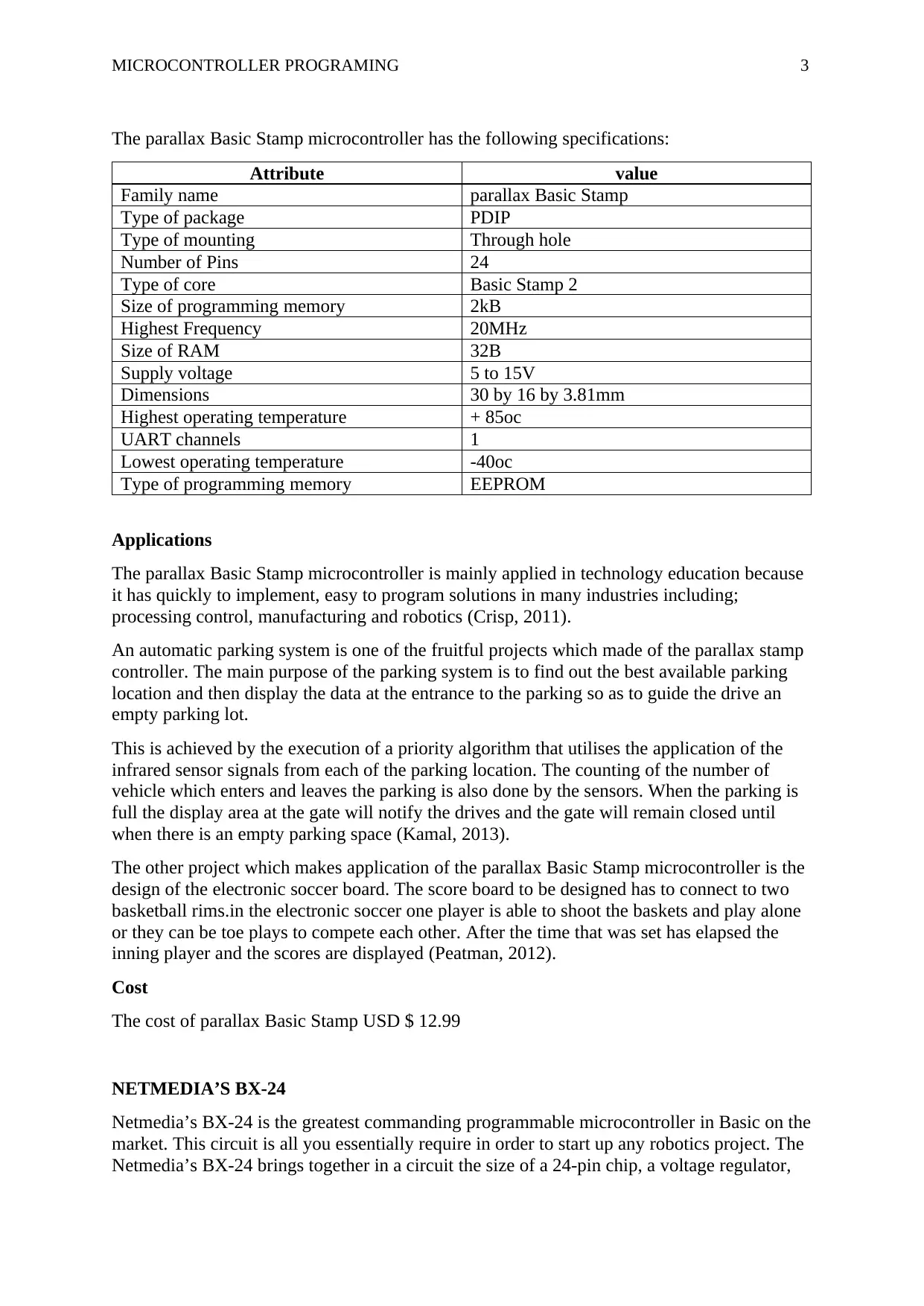
MICROCONTROLLER PROGRAMING 3
The parallax Basic Stamp microcontroller has the following specifications:
Attribute value
Family name parallax Basic Stamp
Type of package PDIP
Type of mounting Through hole
Number of Pins 24
Type of core Basic Stamp 2
Size of programming memory 2kB
Highest Frequency 20MHz
Size of RAM 32B
Supply voltage 5 to 15V
Dimensions 30 by 16 by 3.81mm
Highest operating temperature + 85oc
UART channels 1
Lowest operating temperature -40oc
Type of programming memory EEPROM
Applications
The parallax Basic Stamp microcontroller is mainly applied in technology education because
it has quickly to implement, easy to program solutions in many industries including;
processing control, manufacturing and robotics (Crisp, 2011).
An automatic parking system is one of the fruitful projects which made of the parallax stamp
controller. The main purpose of the parking system is to find out the best available parking
location and then display the data at the entrance to the parking so as to guide the drive an
empty parking lot.
This is achieved by the execution of a priority algorithm that utilises the application of the
infrared sensor signals from each of the parking location. The counting of the number of
vehicle which enters and leaves the parking is also done by the sensors. When the parking is
full the display area at the gate will notify the drives and the gate will remain closed until
when there is an empty parking space (Kamal, 2013).
The other project which makes application of the parallax Basic Stamp microcontroller is the
design of the electronic soccer board. The score board to be designed has to connect to two
basketball rims.in the electronic soccer one player is able to shoot the baskets and play alone
or they can be toe plays to compete each other. After the time that was set has elapsed the
inning player and the scores are displayed (Peatman, 2012).
Cost
The cost of parallax Basic Stamp USD $ 12.99
NETMEDIA’S BX-24
Netmedia’s BX-24 is the greatest commanding programmable microcontroller in Basic on the
market. This circuit is all you essentially require in order to start up any robotics project. The
Netmedia’s BX-24 brings together in a circuit the size of a 24-pin chip, a voltage regulator,
The parallax Basic Stamp microcontroller has the following specifications:
Attribute value
Family name parallax Basic Stamp
Type of package PDIP
Type of mounting Through hole
Number of Pins 24
Type of core Basic Stamp 2
Size of programming memory 2kB
Highest Frequency 20MHz
Size of RAM 32B
Supply voltage 5 to 15V
Dimensions 30 by 16 by 3.81mm
Highest operating temperature + 85oc
UART channels 1
Lowest operating temperature -40oc
Type of programming memory EEPROM
Applications
The parallax Basic Stamp microcontroller is mainly applied in technology education because
it has quickly to implement, easy to program solutions in many industries including;
processing control, manufacturing and robotics (Crisp, 2011).
An automatic parking system is one of the fruitful projects which made of the parallax stamp
controller. The main purpose of the parking system is to find out the best available parking
location and then display the data at the entrance to the parking so as to guide the drive an
empty parking lot.
This is achieved by the execution of a priority algorithm that utilises the application of the
infrared sensor signals from each of the parking location. The counting of the number of
vehicle which enters and leaves the parking is also done by the sensors. When the parking is
full the display area at the gate will notify the drives and the gate will remain closed until
when there is an empty parking space (Kamal, 2013).
The other project which makes application of the parallax Basic Stamp microcontroller is the
design of the electronic soccer board. The score board to be designed has to connect to two
basketball rims.in the electronic soccer one player is able to shoot the baskets and play alone
or they can be toe plays to compete each other. After the time that was set has elapsed the
inning player and the scores are displayed (Peatman, 2012).
Cost
The cost of parallax Basic Stamp USD $ 12.99
NETMEDIA’S BX-24
Netmedia’s BX-24 is the greatest commanding programmable microcontroller in Basic on the
market. This circuit is all you essentially require in order to start up any robotics project. The
Netmedia’s BX-24 brings together in a circuit the size of a 24-pin chip, a voltage regulator,
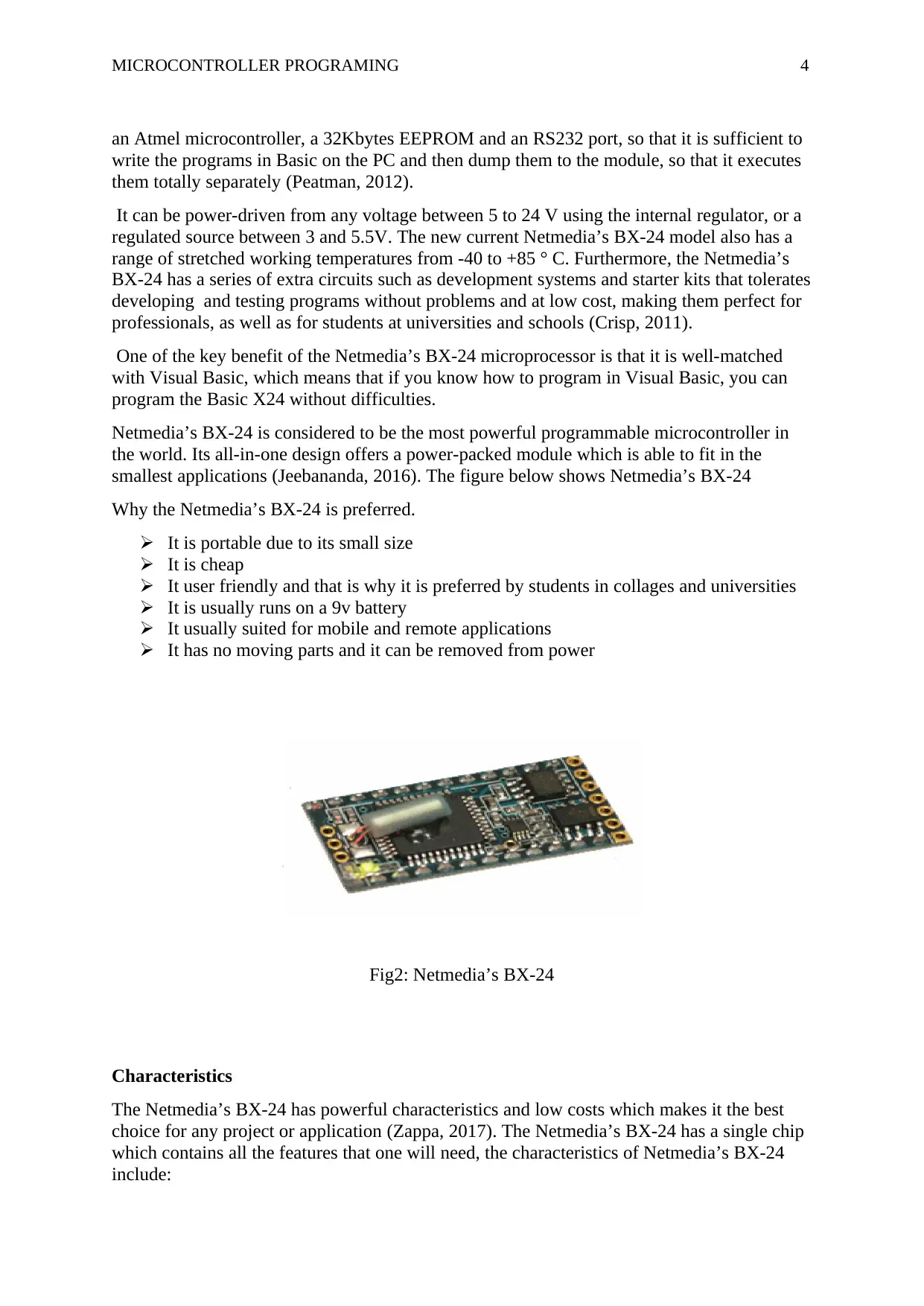
MICROCONTROLLER PROGRAMING 4
an Atmel microcontroller, a 32Kbytes EEPROM and an RS232 port, so that it is sufficient to
write the programs in Basic on the PC and then dump them to the module, so that it executes
them totally separately (Peatman, 2012).
It can be power-driven from any voltage between 5 to 24 V using the internal regulator, or a
regulated source between 3 and 5.5V. The new current Netmedia’s BX-24 model also has a
range of stretched working temperatures from -40 to +85 ° C. Furthermore, the Netmedia’s
BX-24 has a series of extra circuits such as development systems and starter kits that tolerates
developing and testing programs without problems and at low cost, making them perfect for
professionals, as well as for students at universities and schools (Crisp, 2011).
One of the key benefit of the Netmedia’s BX-24 microprocessor is that it is well-matched
with Visual Basic, which means that if you know how to program in Visual Basic, you can
program the Basic X24 without difficulties.
Netmedia’s BX-24 is considered to be the most powerful programmable microcontroller in
the world. Its all-in-one design offers a power-packed module which is able to fit in the
smallest applications (Jeebananda, 2016). The figure below shows Netmedia’s BX-24
Why the Netmedia’s BX-24 is preferred.
It is portable due to its small size
It is cheap
It user friendly and that is why it is preferred by students in collages and universities
It is usually runs on a 9v battery
It usually suited for mobile and remote applications
It has no moving parts and it can be removed from power
Fig2: Netmedia’s BX-24
Characteristics
The Netmedia’s BX-24 has powerful characteristics and low costs which makes it the best
choice for any project or application (Zappa, 2017). The Netmedia’s BX-24 has a single chip
which contains all the features that one will need, the characteristics of Netmedia’s BX-24
include:
an Atmel microcontroller, a 32Kbytes EEPROM and an RS232 port, so that it is sufficient to
write the programs in Basic on the PC and then dump them to the module, so that it executes
them totally separately (Peatman, 2012).
It can be power-driven from any voltage between 5 to 24 V using the internal regulator, or a
regulated source between 3 and 5.5V. The new current Netmedia’s BX-24 model also has a
range of stretched working temperatures from -40 to +85 ° C. Furthermore, the Netmedia’s
BX-24 has a series of extra circuits such as development systems and starter kits that tolerates
developing and testing programs without problems and at low cost, making them perfect for
professionals, as well as for students at universities and schools (Crisp, 2011).
One of the key benefit of the Netmedia’s BX-24 microprocessor is that it is well-matched
with Visual Basic, which means that if you know how to program in Visual Basic, you can
program the Basic X24 without difficulties.
Netmedia’s BX-24 is considered to be the most powerful programmable microcontroller in
the world. Its all-in-one design offers a power-packed module which is able to fit in the
smallest applications (Jeebananda, 2016). The figure below shows Netmedia’s BX-24
Why the Netmedia’s BX-24 is preferred.
It is portable due to its small size
It is cheap
It user friendly and that is why it is preferred by students in collages and universities
It is usually runs on a 9v battery
It usually suited for mobile and remote applications
It has no moving parts and it can be removed from power
Fig2: Netmedia’s BX-24
Characteristics
The Netmedia’s BX-24 has powerful characteristics and low costs which makes it the best
choice for any project or application (Zappa, 2017). The Netmedia’s BX-24 has a single chip
which contains all the features that one will need, the characteristics of Netmedia’s BX-24
include:
Secure Best Marks with AI Grader
Need help grading? Try our AI Grader for instant feedback on your assignments.
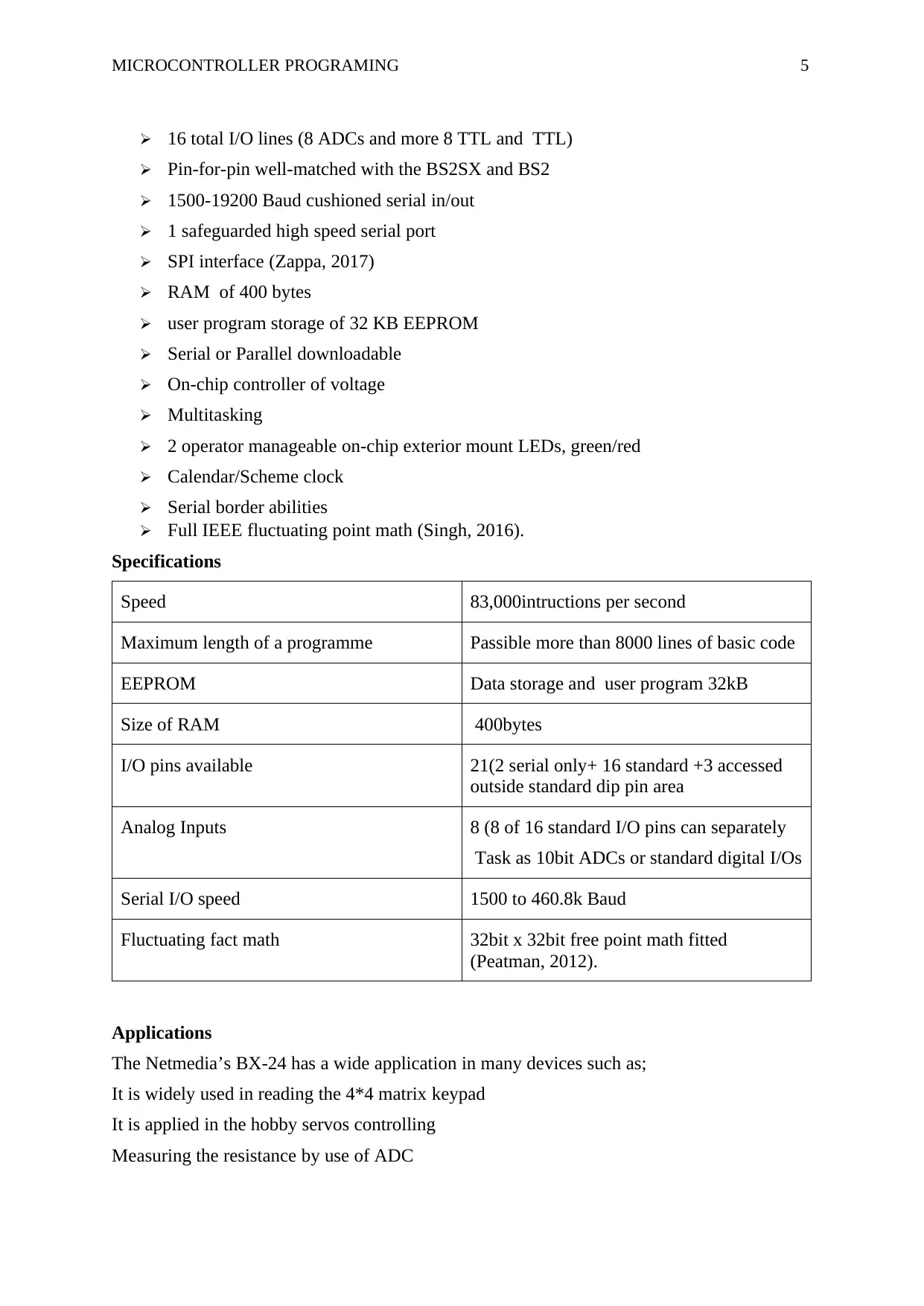
MICROCONTROLLER PROGRAMING 5
16 total I/O lines (8 ADCs and more 8 TTL and TTL)
Pin-for-pin well-matched with the BS2SX and BS2
1500-19200 Baud cushioned serial in/out
1 safeguarded high speed serial port
SPI interface (Zappa, 2017)
RAM of 400 bytes
user program storage of 32 KB EEPROM
Serial or Parallel downloadable
On-chip controller of voltage
Multitasking
2 operator manageable on-chip exterior mount LEDs, green/red
Calendar/Scheme clock
Serial border abilities
Full IEEE fluctuating point math (Singh, 2016).
Specifications
Speed 83,000intructions per second
Maximum length of a programme Passible more than 8000 lines of basic code
EEPROM Data storage and user program 32kB
Size of RAM 400bytes
I/O pins available 21(2 serial only+ 16 standard +3 accessed
outside standard dip pin area
Analog Inputs 8 (8 of 16 standard I/O pins can separately
Task as 10bit ADCs or standard digital I/Os
Serial I/O speed 1500 to 460.8k Baud
Fluctuating fact math 32bit x 32bit free point math fitted
(Peatman, 2012).
Applications
The Netmedia’s BX-24 has a wide application in many devices such as;
It is widely used in reading the 4*4 matrix keypad
It is applied in the hobby servos controlling
Measuring the resistance by use of ADC
16 total I/O lines (8 ADCs and more 8 TTL and TTL)
Pin-for-pin well-matched with the BS2SX and BS2
1500-19200 Baud cushioned serial in/out
1 safeguarded high speed serial port
SPI interface (Zappa, 2017)
RAM of 400 bytes
user program storage of 32 KB EEPROM
Serial or Parallel downloadable
On-chip controller of voltage
Multitasking
2 operator manageable on-chip exterior mount LEDs, green/red
Calendar/Scheme clock
Serial border abilities
Full IEEE fluctuating point math (Singh, 2016).
Specifications
Speed 83,000intructions per second
Maximum length of a programme Passible more than 8000 lines of basic code
EEPROM Data storage and user program 32kB
Size of RAM 400bytes
I/O pins available 21(2 serial only+ 16 standard +3 accessed
outside standard dip pin area
Analog Inputs 8 (8 of 16 standard I/O pins can separately
Task as 10bit ADCs or standard digital I/Os
Serial I/O speed 1500 to 460.8k Baud
Fluctuating fact math 32bit x 32bit free point math fitted
(Peatman, 2012).
Applications
The Netmedia’s BX-24 has a wide application in many devices such as;
It is widely used in reading the 4*4 matrix keypad
It is applied in the hobby servos controlling
Measuring the resistance by use of ADC
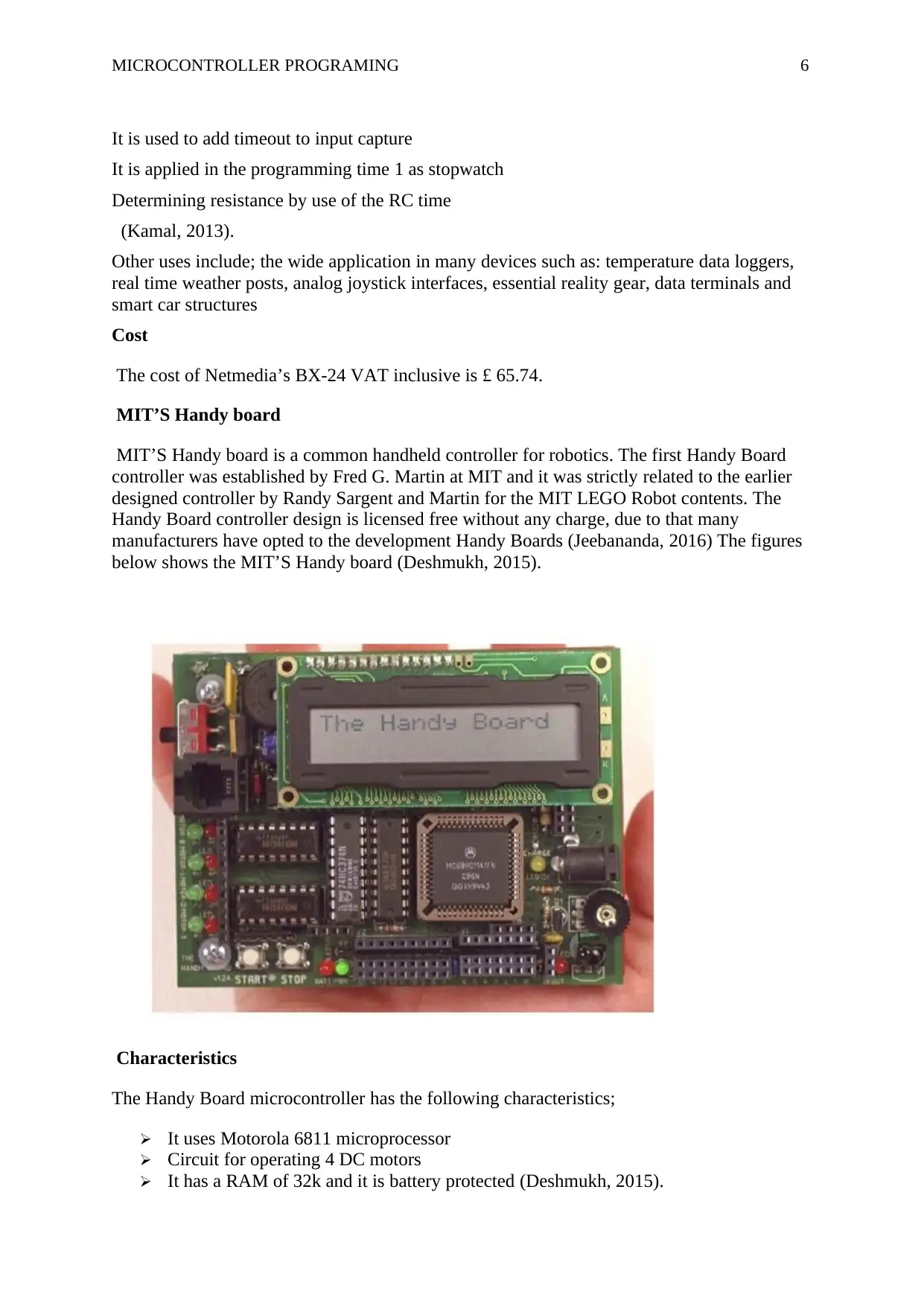
MICROCONTROLLER PROGRAMING 6
It is used to add timeout to input capture
It is applied in the programming time 1 as stopwatch
Determining resistance by use of the RC time
(Kamal, 2013).
Other uses include; the wide application in many devices such as: temperature data loggers,
real time weather posts, analog joystick interfaces, essential reality gear, data terminals and
smart car structures
Cost
The cost of Netmedia’s BX-24 VAT inclusive is £ 65.74.
MIT’S Handy board
MIT’S Handy board is a common handheld controller for robotics. The first Handy Board
controller was established by Fred G. Martin at MIT and it was strictly related to the earlier
designed controller by Randy Sargent and Martin for the MIT LEGO Robot contents. The
Handy Board controller design is licensed free without any charge, due to that many
manufacturers have opted to the development Handy Boards (Jeebananda, 2016) The figures
below shows the MIT’S Handy board (Deshmukh, 2015).
Characteristics
The Handy Board microcontroller has the following characteristics;
It uses Motorola 6811 microprocessor
Circuit for operating 4 DC motors
It has a RAM of 32k and it is battery protected (Deshmukh, 2015).
It is used to add timeout to input capture
It is applied in the programming time 1 as stopwatch
Determining resistance by use of the RC time
(Kamal, 2013).
Other uses include; the wide application in many devices such as: temperature data loggers,
real time weather posts, analog joystick interfaces, essential reality gear, data terminals and
smart car structures
Cost
The cost of Netmedia’s BX-24 VAT inclusive is £ 65.74.
MIT’S Handy board
MIT’S Handy board is a common handheld controller for robotics. The first Handy Board
controller was established by Fred G. Martin at MIT and it was strictly related to the earlier
designed controller by Randy Sargent and Martin for the MIT LEGO Robot contents. The
Handy Board controller design is licensed free without any charge, due to that many
manufacturers have opted to the development Handy Boards (Jeebananda, 2016) The figures
below shows the MIT’S Handy board (Deshmukh, 2015).
Characteristics
The Handy Board microcontroller has the following characteristics;
It uses Motorola 6811 microprocessor
Circuit for operating 4 DC motors
It has a RAM of 32k and it is battery protected (Deshmukh, 2015).
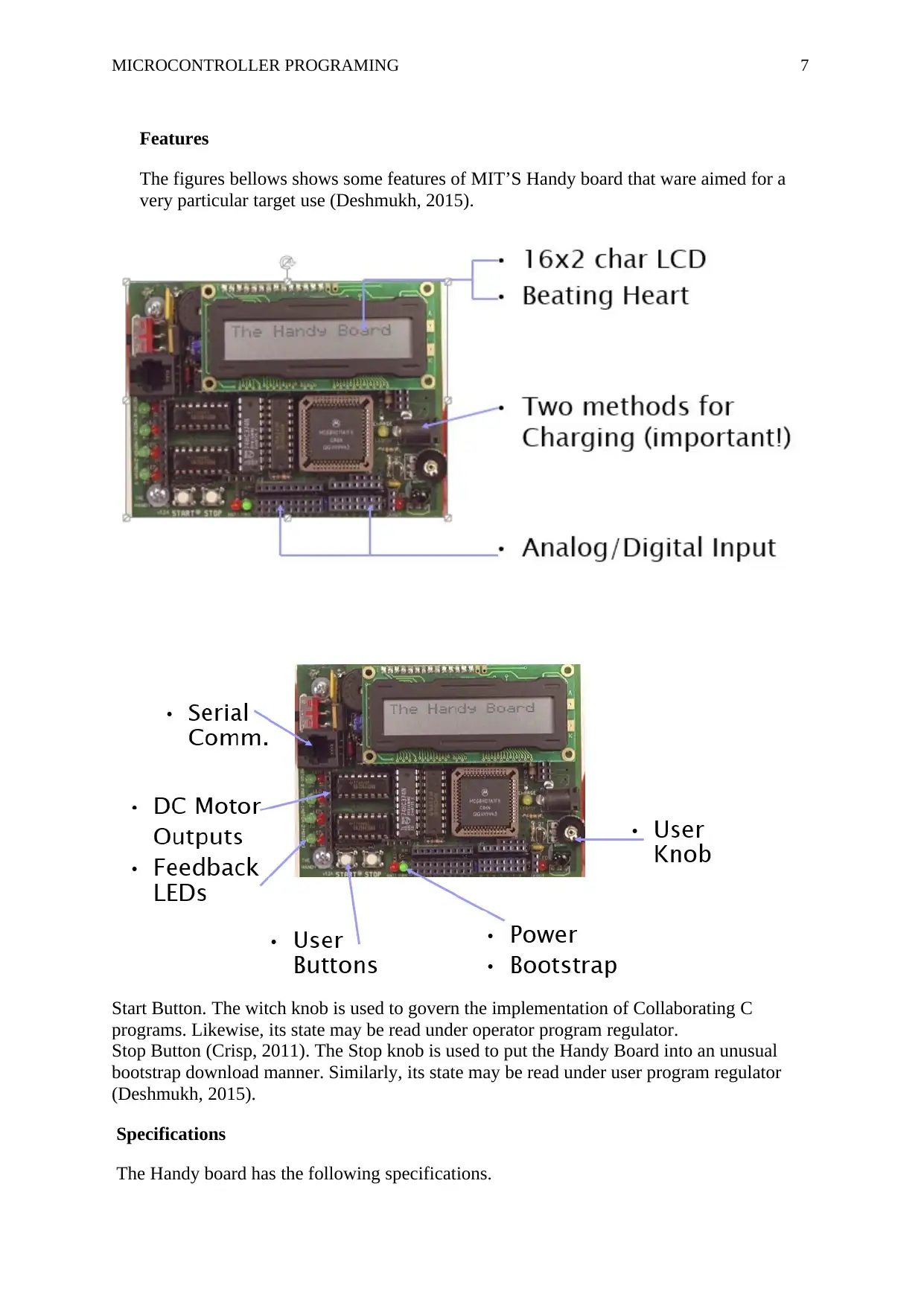
MICROCONTROLLER PROGRAMING 7
Features
The figures bellows shows some features of MIT’S Handy board that ware aimed for a
very particular target use (Deshmukh, 2015).
Start Button. The witch knob is used to govern the implementation of Collaborating C
programs. Likewise, its state may be read under operator program regulator.
Stop Button (Crisp, 2011). The Stop knob is used to put the Handy Board into an unusual
bootstrap download manner. Similarly, its state may be read under user program regulator
(Deshmukh, 2015).
Specifications
The Handy board has the following specifications.
Features
The figures bellows shows some features of MIT’S Handy board that ware aimed for a
very particular target use (Deshmukh, 2015).
Start Button. The witch knob is used to govern the implementation of Collaborating C
programs. Likewise, its state may be read under operator program regulator.
Stop Button (Crisp, 2011). The Stop knob is used to put the Handy Board into an unusual
bootstrap download manner. Similarly, its state may be read under user program regulator
(Deshmukh, 2015).
Specifications
The Handy board has the following specifications.
Paraphrase This Document
Need a fresh take? Get an instant paraphrase of this document with our AI Paraphraser
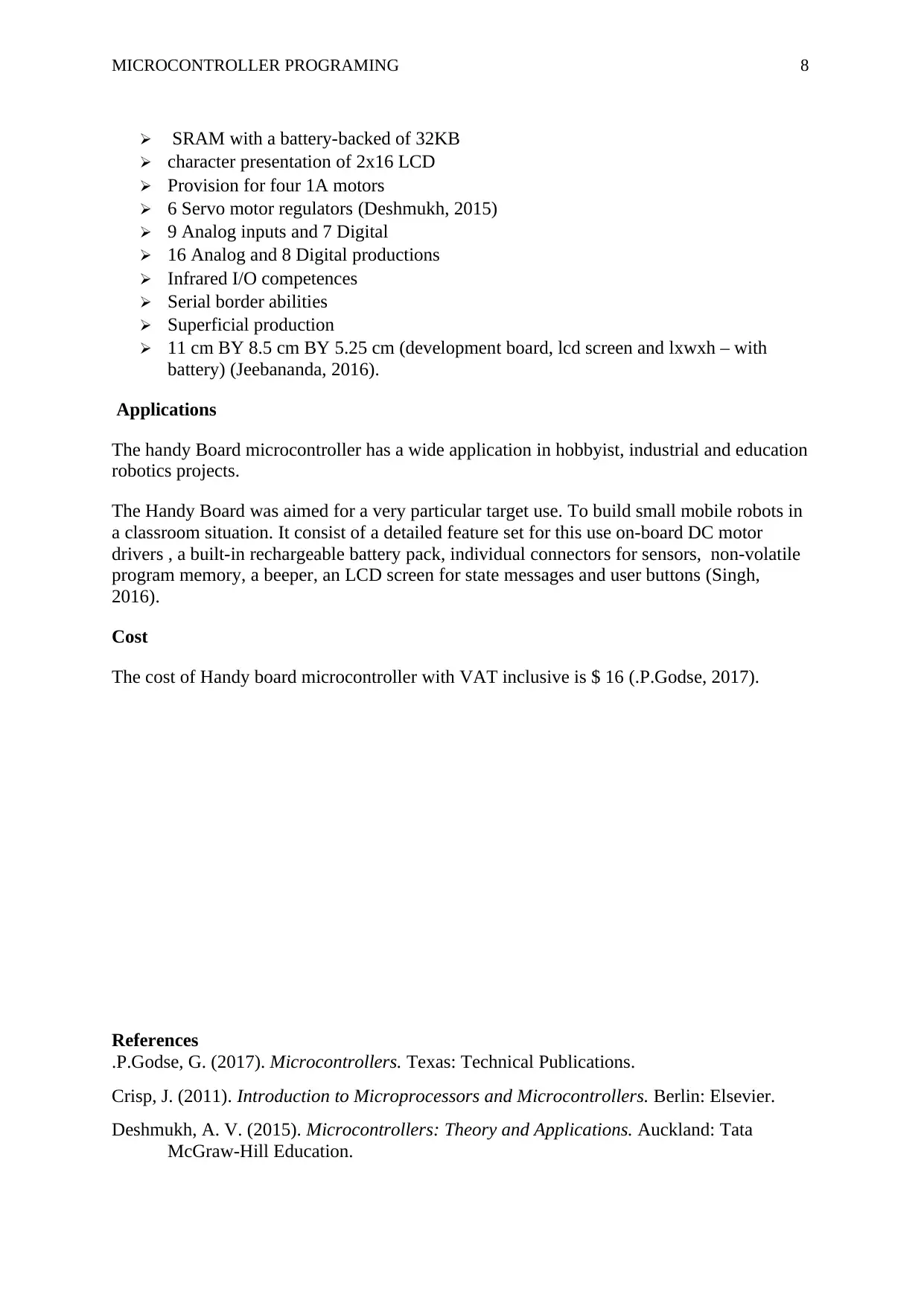
MICROCONTROLLER PROGRAMING 8
SRAM with a battery-backed of 32KB
character presentation of 2x16 LCD
Provision for four 1A motors
6 Servo motor regulators (Deshmukh, 2015)
9 Analog inputs and 7 Digital
16 Analog and 8 Digital productions
Infrared I/O competences
Serial border abilities
Superficial production
11 cm BY 8.5 cm BY 5.25 cm (development board, lcd screen and lxwxh – with
battery) (Jeebananda, 2016).
Applications
The handy Board microcontroller has a wide application in hobbyist, industrial and education
robotics projects.
The Handy Board was aimed for a very particular target use. To build small mobile robots in
a classroom situation. It consist of a detailed feature set for this use on-board DC motor
drivers , a built-in rechargeable battery pack, individual connectors for sensors, non-volatile
program memory, a beeper, an LCD screen for state messages and user buttons (Singh,
2016).
Cost
The cost of Handy board microcontroller with VAT inclusive is $ 16 (.P.Godse, 2017).
References
.P.Godse, G. (2017). Microcontrollers. Texas: Technical Publications.
Crisp, J. (2011). Introduction to Microprocessors and Microcontrollers. Berlin: Elsevier.
Deshmukh, A. V. (2015). Microcontrollers: Theory and Applications. Auckland: Tata
McGraw-Hill Education.
SRAM with a battery-backed of 32KB
character presentation of 2x16 LCD
Provision for four 1A motors
6 Servo motor regulators (Deshmukh, 2015)
9 Analog inputs and 7 Digital
16 Analog and 8 Digital productions
Infrared I/O competences
Serial border abilities
Superficial production
11 cm BY 8.5 cm BY 5.25 cm (development board, lcd screen and lxwxh – with
battery) (Jeebananda, 2016).
Applications
The handy Board microcontroller has a wide application in hobbyist, industrial and education
robotics projects.
The Handy Board was aimed for a very particular target use. To build small mobile robots in
a classroom situation. It consist of a detailed feature set for this use on-board DC motor
drivers , a built-in rechargeable battery pack, individual connectors for sensors, non-volatile
program memory, a beeper, an LCD screen for state messages and user buttons (Singh,
2016).
Cost
The cost of Handy board microcontroller with VAT inclusive is $ 16 (.P.Godse, 2017).
References
.P.Godse, G. (2017). Microcontrollers. Texas: Technical Publications.
Crisp, J. (2011). Introduction to Microprocessors and Microcontrollers. Berlin: Elsevier.
Deshmukh, A. V. (2015). Microcontrollers: Theory and Applications. Auckland: Tata
McGraw-Hill Education.

MICROCONTROLLER PROGRAMING 9
Jeebananda, P. (2016). MICROPROCESSORS AND MICROCONTROLLERS. Chicago: PHI
Learning Pvt. Ltd.
Kamal, R. (2013). Microcontrollers: Architecture, Programming, Interfacing and System
Design. Chicago: Pearson Education India.
Peatman, J. B. (2012). Design with PIC Microcontrollers. London: Prentice Hall.
Singh, R. (2016). Advanced Microprocessors and Microcontrollers. Sydney: New Age
International.
Zappa, F. (2017). Microcontrollers. Hardware and Firmware for 8-bit and 32-bit devices.
Paris: Società Editrice Esculapio.
Jeebananda, P. (2016). MICROPROCESSORS AND MICROCONTROLLERS. Chicago: PHI
Learning Pvt. Ltd.
Kamal, R. (2013). Microcontrollers: Architecture, Programming, Interfacing and System
Design. Chicago: Pearson Education India.
Peatman, J. B. (2012). Design with PIC Microcontrollers. London: Prentice Hall.
Singh, R. (2016). Advanced Microprocessors and Microcontrollers. Sydney: New Age
International.
Zappa, F. (2017). Microcontrollers. Hardware and Firmware for 8-bit and 32-bit devices.
Paris: Società Editrice Esculapio.
1 out of 9
Your All-in-One AI-Powered Toolkit for Academic Success.
+13062052269
info@desklib.com
Available 24*7 on WhatsApp / Email
![[object Object]](/_next/static/media/star-bottom.7253800d.svg)
Unlock your academic potential
© 2024 | Zucol Services PVT LTD | All rights reserved.


